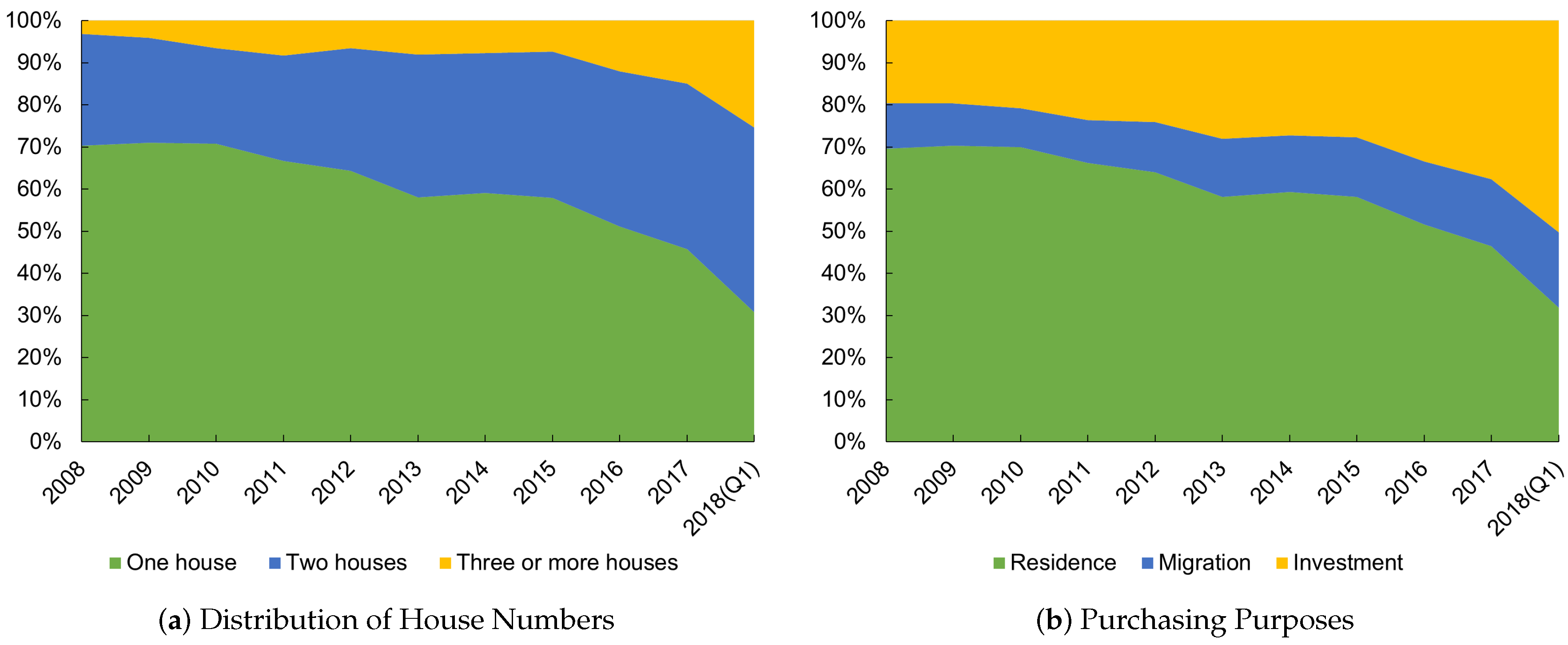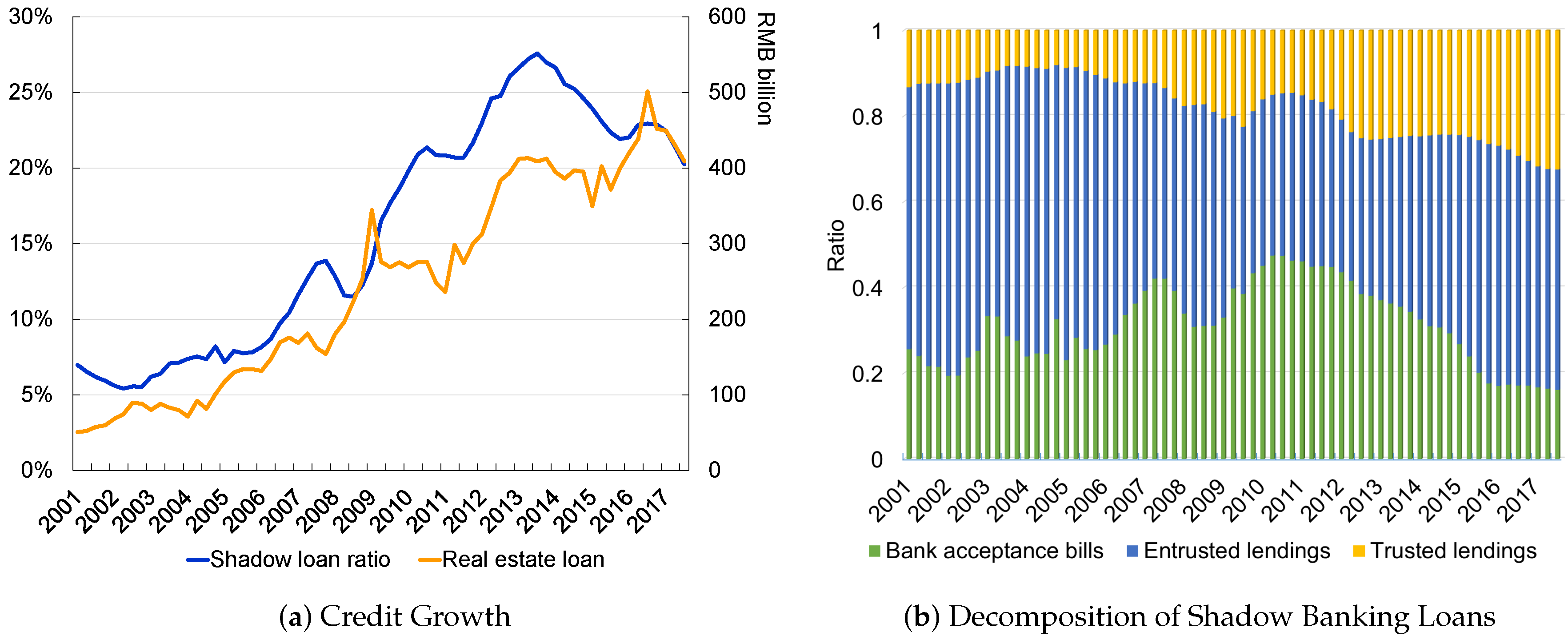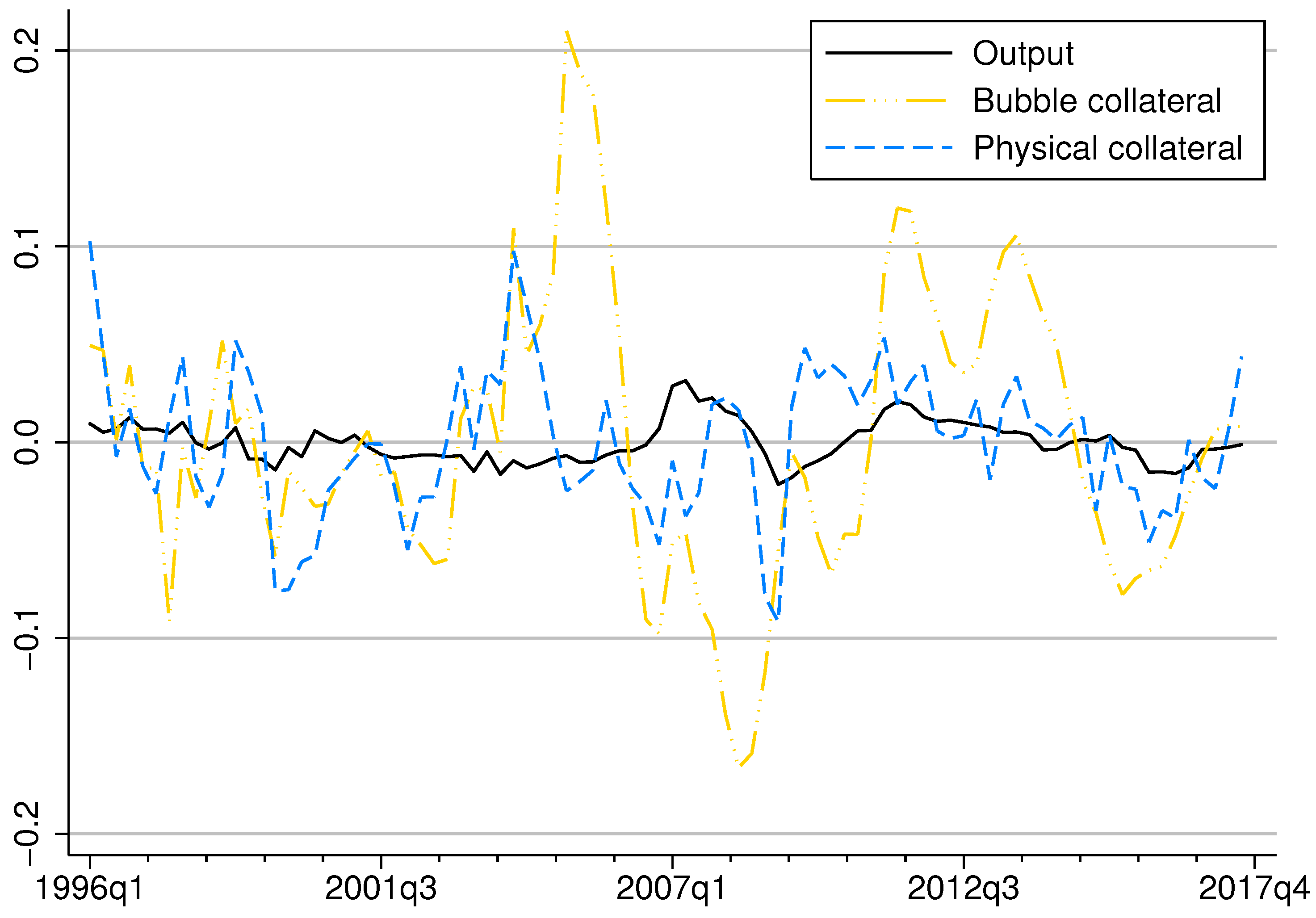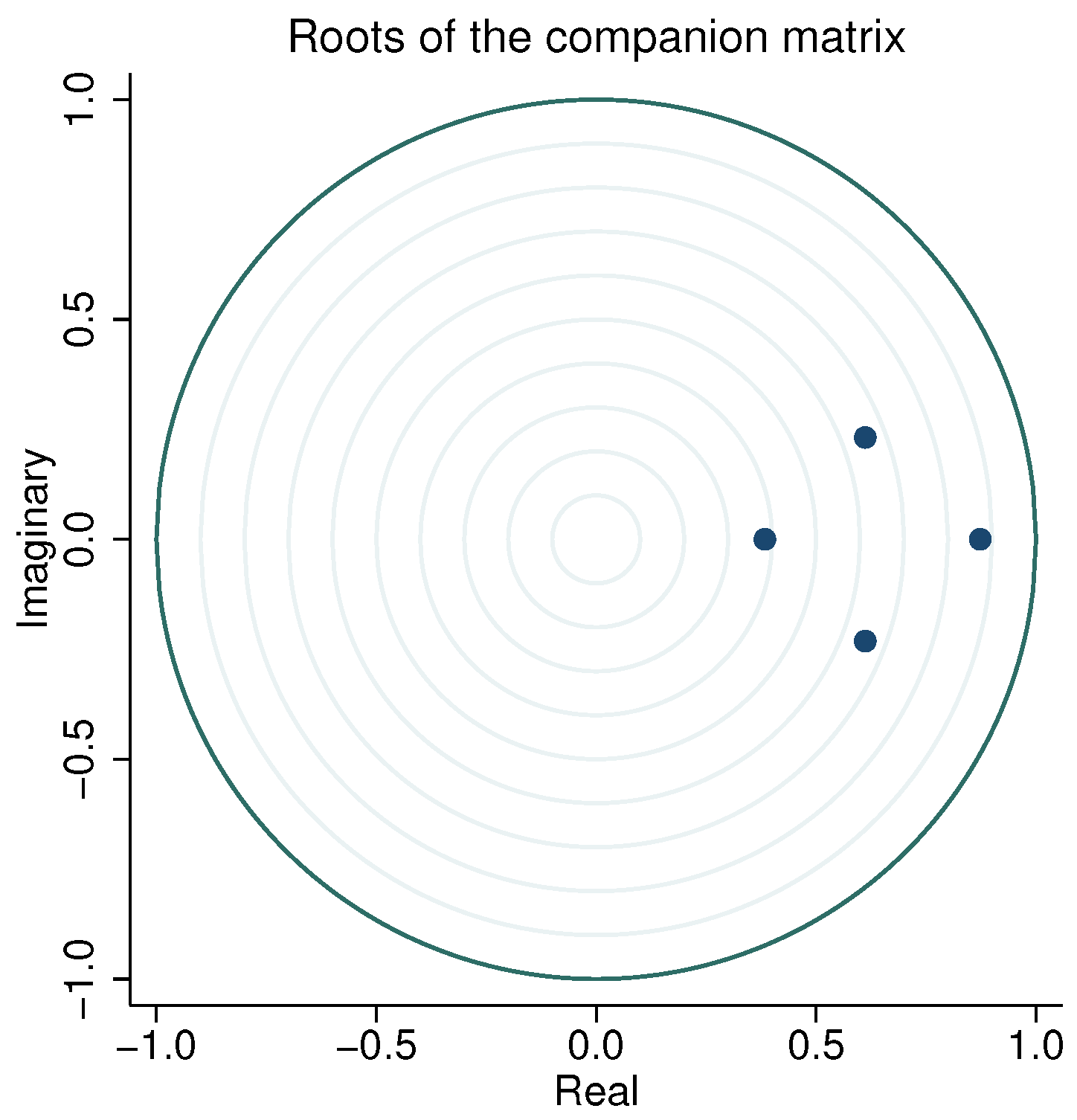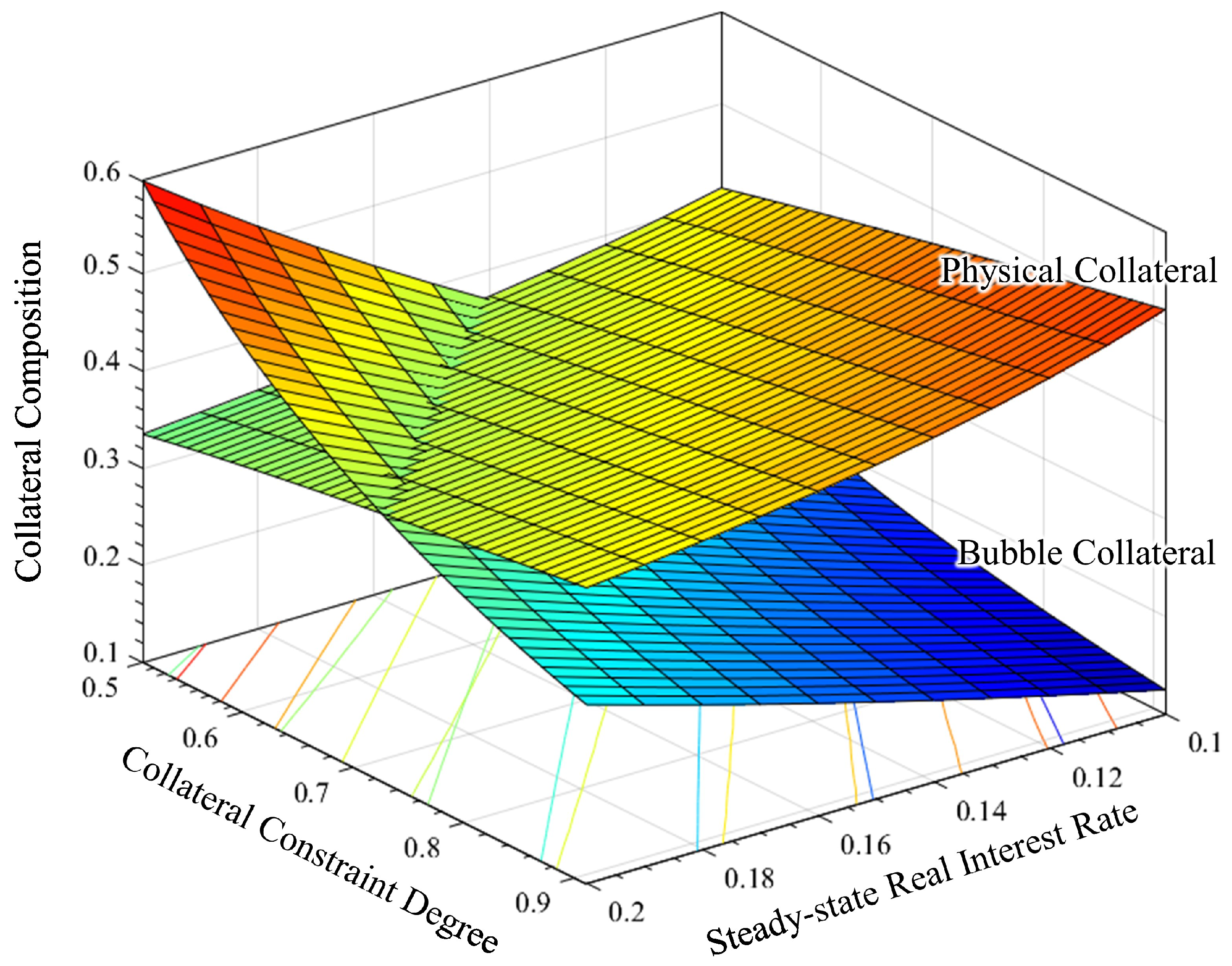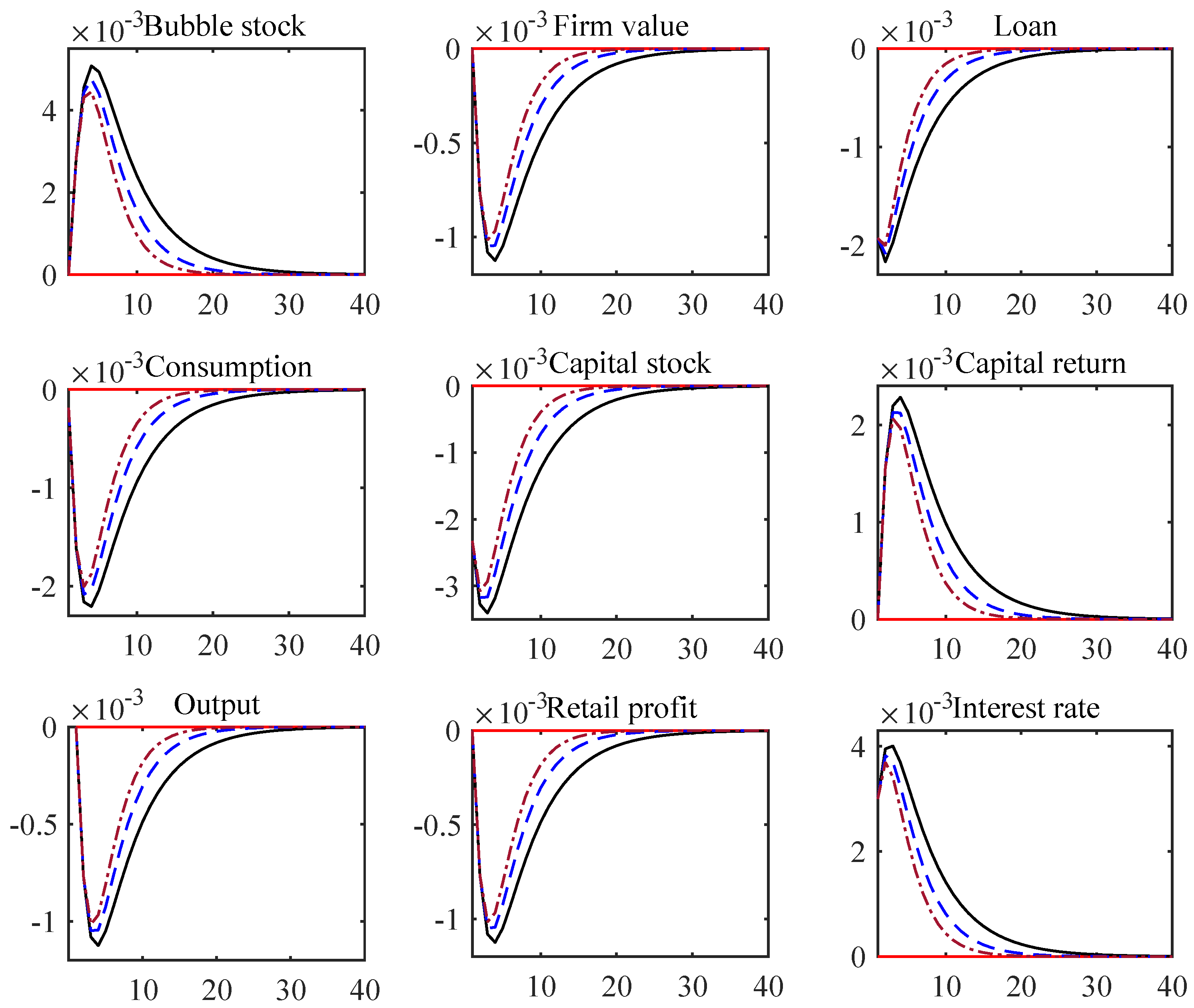1. Introduction
After the 2008 global financial crisis, both the housing market and the stock market all over the world showed drastic fluctuations in asset prices, in a general background of an imperfect credit environment. Should government strengthen policy control to manage inflated asset bubbles? Can a rise in interest rate hold down bubbles efficiently and can contractionary policy implementations mitigate any economic downturn? This ostensibly reasonable belief has reached a general consensus in theory and practically guides the interventions and supervisions in financial markets for years. Nevertheless, there have been dozens of counterexamples of a “price puzzle” where stringent interest rate policy pushes up asset prices and inflates bubbles, which has drawn public attention.
At the same time, in China, in face of the soaring housing prices and the over-leveraged financial systems of recent years, the Chinese government and the People’s Bank of China have been responding actively and taking varying measures to harness booming bubbles. On the quantity side, the government has put forward a series of control policies including home-purchasing limits and property-loan restrictions. On the price side, the central bank has continuously raised reverse repo rates and has even directly lifted loan interest rates. The ex post facto effects, however, are by no means satisfactory. In the past decade, real estate properties have been disproportionately purchased by investors who already own houses, vividly displayed in
Figure 1a. Taking a close look at their purchasing reasons according to the nationally representative China Household Finance Survey (CHFS),
Figure 1b manifests a clear purpose of speculation and an unstoppable build-up of leverage in real estate markets.
Despite the upsurge bubbles in housing markets, emerging issues in debt markets put financial supervisors in a difficult position, since the austerity measures they implemented and the deleveraging campaign they launched were substantially criticized for their ineffectiveness. A quick glimpse at
Figure 2 is enough to view the ever-increasing debt burden and the unsatisfactory situations of China’s credit market. The quarterly data in
Figure 2 is extracted from the dataset of China’s macroeconomic time series constructed for [
1], which is a perfect and comprehensive collection of the raw data from China’s National Bureau of Statistics and Ministry of Finance and the People’s Bank of China.
Starting from 2001, two time series of
shadow loan ratios and
real estate loans present an overwhelming growth pattern of credit scale in
Figure 2a. If we examine the shadow banking loan in its subdivisions of
bank acceptance bills,
entrusted lendings, and
trusted lendings,
Figure 2b clearly reveals the aggressive expansion of trust and entrust loans not included in the balance sheets, which for this reason implicitly hides default risks to a large extent and creates ascending leverage in financial systems. Until 2018, the proportion of
bank acceptance bills has shrunk to 16%, from the summit point of 47% in 2011.
In a long-term sustainable financial system, moderate leverage ratios and stable asset prices are essential to minimize systematic risks and achieve the goal of steady development. In particular with regard to the real estate market, a small or moderate bubble implies that housing price faithfully reflect fundamental, so that common residents find it easy to make rational migration decisions and so that construction enterprises make good use of energy resources. The alternative scenario is more worrying: Unexpected market prices mislead urban change, unavoidably causing a loss to agricultural land that could have been optimally allocated and efficiently utilized for cultivation and afforestation.
Despite the best of intentions and efforts, as a matter of fact, neither the present strict control measures on real estate nor stringent market regulations on credit are of great advantage to the long-term sustainability and robust growth in housing markets, at least based on the evidence in China. Why does the contractionary monetary policy in a harsh credit environment fail to change these problematic situations? What role should financial supervisors play in regulating asset bubbles in the emergence of sustainable finance? These are all pretty significant issues worth addressing.
The contribution of this paper is summarized as follows. First, most of the scholars who follow housing bubbles with interest concentrate on the U.S. market, as in [
2,
3,
4,
5], yet unfortunately have not dug into the Chinese economy with enormous potential. In addition, among all the abundant research devoted to harness housing bubbles, previous scholars have seldom conducted a systemic study on the compound effect of a twofold austerity measure, featured by an upward interest rate and a rigid credit restriction. Our work contributes to the existing literature and adds to the above research gaps by investigating thoroughly the unintended consequences of this twofold policy measure and providing a plausible explanation for the unsolved real estate bubbles. Starting from the counter-intuitive phenomenon of the swelling asset bubble and deteriorated debt conditions under tight monetary policies and strong deleveraging operations in China’s financial market, this paper attempts to address this issue by developing a generalized overlapping generation (OLG) model in a standard New Keynesian framework, widely applied in the literature on asset markets and monetary policy.
Second, while the literature of monetary effects on asset prices is broad and sufficient, it lacks a thorough inquiry into one essential function of bubble assets: mortgage financing. This paper places particular emphasis on the pledgeability of rational asset bubbles in investor collateral composition and explores the effects of changes in market interest rates from the perspective of a collateral mechanism in monetary transmissions. As heated debates pay much attention to the growing risks posed by the bulky share of pledged real estates and accumulated liquidity pressures on borrowers, this work has practical relevance to the future sustainability and development of the Chinese financial market, which is closely bound up with the global economy at a higher level from the current situation.
Furthermore, we also make theoretical extensions on a few pioneering studies: We augment [
6] by allowing entrepreneurs and general workers to hold bubbles. We also justify the crowd-out effect of bubbles on capital accumulation in [
7,
8]. Infinite-horizon models, e.g., [
9,
10,
11], focus on the effects on investment and the allocation of stock price bubbles with positive dividends. Our work extends and modifies them by concentrating on the pure bubbles that serve as a store of value traded by overlapping agents, aiming at better fitting the reality of housing markets and evaluating the comprehensive influence in overlapping generations.
The line of reasoning in our logical framework processes is described below: Rational bubbles enter asset markets following [
12] and serve as a portion of collaterals used for loan investment of entrepreneurs (henceforth referred to as “bubble collateral”). These intrinsically valueless assets produce no real payoff, expand when market return increases, and further appreciate with pledgeable feature. Meanwhile, on the production side, the correspondingly rising cost brought by increased interest rate hampers capital accumulation and production, depreciating the aggregate value of ordinary pledgeable assets (referred to as “physical collateral”). The composition of bubble and physical collaterals is utilized by representative investors in our model to satisfy their liquidity demand. In this situation, when investors bear stringent credit constraints and cannot borrow enough money with the available physical collateral, they will have motivations to add holdings for bubbles to alleviate the liquidity shortage. Additionally, taking the collateral mechanism in credit constraints into consideration, an intuitive inference extended here is that the above expansion effect of the rising interest rate on asset bubbles will be further reinforced if the borrowing restrictions become more rigid.
The rest of this paper is organized as follows:
Section 2 summarizes related literature.
Section 3 displays the stylized facts regarding bubbles and credit in China and empirical evidence with respect to a standard interest rate shock.
Section 4 sets up the complete theoretical model considering credit frictions and bubble asset pledgeability.
Section 5 discusses in detail the mathematical and numerical results, including the steady-state analysis of bubbly equilibrium, the comparative statics of collateral composition evolutions and impulse responses under the change in interest rates and the degree of credit frictions.
Section 6 concludes, puts forward policy implications, and discourses limitations and future research.
Appendix A and
Appendix B contain technical proofs.
2. Literature Review
In view of the special nature of a speculative bubble generating no endogenous productivity, it is appropriate to regard it as an inherently valueless premium above price fundamental, within the scope of a pure rational bubble attached to positive price. In real transactions, dealers acknowledge that bubbles can burst in the unknown future. As is early illustrated in [
13], the price of a speculative bubble is driven by the self-fulfilling mechanism of expectation. Bubbles expand as agents have confidence in sustained economic growth. With a rising risk premium and a rigid credit condition, continuous bubble inflation finally triggers a sudden collapse in investor sentiment and subsequently provokes a slump in financial markets. To make it worse, when we look into the real estate asset market specifically, a housing asset bears expensive transaction costs and confined short selling as a typical class of illiquid asset. As a factual matter, the frenzied overbuilding may be largely ascribed to an endogenous housing supply, well explained in [
14]. A more inelastic housing supply breeds bubbles more easily, extends its duration, and exerts a profound impact on new construction and public welfare. In light of the grave consequences of bubble bursting, whether and how government and supervisors should react to asset bubbles have caused much controversy in academic and political circles.
Prior scholars who are in favor of tight policy have focused on the effects of the “reverse operation” on curbing the steep rise of asset prices, appeasing fluctuated financial markets and in this manner benefiting macro economic stability. The authors in [
15] pointed out the ignorance of future price variations in the monetary policy regime of inflation targeting, and claimed that this weakness could be overcome by letting interest rates react to asset prices. Based on the theoretical framework of [
16], the generation and evolution of bubbles have no influence on the future path of expected inflation, since rational agents perfectly anticipate that bubbles are destined to vanish in the future. Under this circumstance, the prevailing inflation targeting is invalid and could only apply “reverse operation” to asset prices so as to cool down the overheated economy. Soon after, the conference report of [
17] speaks highly of the superiority of the “leaning against the wind” policy in regulating financial markets. Subsequent research in the Bank for International Settlements [
18] and empirical evidence in Singapore [
19] both back up this argument. Using a Bayesian likelihood approach, the supplement role of prompt policy adjustments to macro prudent policies has been well reflected in the estimated DSGE model in [
20]. Similarly, the authors in [
21] highlight the complementary effect of tight interest rates on banking supervision and regulation. Of recent years, in regard to some dissenting opinions of strict actions and market controls, the authors in [
22] stress the far-reaching positive impacts on long-run sustained economic stability at the expense of sacrifice for the moment. Likewise, in a forthcoming theoretical study, the authors in [
23] arrive at the conventional conclusion that a tightening policy control is optimal for decreasing bubble fluctuation.
In practice, however, numerous unsuccessful cases arouse suspicion for the actual effect of austerity campaigns. It is undeniable that a promotion of interest rate raises borrowing costs and harms material production. When the regulators do not have a clear knowledge of whether the climbing prices and red-hot economy stem from positive technological advances or bloated financial bubbles, a blind intervention for the purpose of stabilizing financial markets is very likely to generate the opposite outcome. The famous discussion in [
24,
25] conservatively advocates a “benign neglect” strategy when the economy confronts multiple shocks. This argument is soon supported and underlined by the authors in [
26], who point out the possible scenario that one action aiming at quelling volatility in a certain market transfers pressure to other markets in the general equilibrium system and in the end disturbs market order through the feedback loop among market traders. Indeed, improper interference and credit squeeze can give rise to bubble collapses and the closely following violent aftermath of financial turmoil, discussed in detail by the authors in [
27]. Fully aware of the great transformation with the advent of Economic and Monetary Union (EMU), the authors in [
28] showed that demographic factors encourage housing bubbles to expand under relaxed financial constraints in Ireland and Spain. By virtue of the idiosyncrasy in housing markets across the Euro Area, the EMU monetary policy that targets the region as a whole barely works to control bubbles. For the sake of promoting sustainable economic growth associated with a compatible throughput rate not exceeding the carrying capacity of our finite planet, the authors in [
29] call for the necessary restoration of money creation to support sufficient investment in pivotal public goods, with the cardinal aim of realizing the transition to a steady-state economy based on harmony and well-being. More recently, the authors in [
12] account for the root reason why a rational asset bubble has a growth rate in accord with the market interest rate in partial equilibrium, and then set up a succinct and elegant general equilibrium model demonstrating that the design of an optimal monetary policy should judge and weigh the trade-off between bubble stabilization and inflation stabilization, and not only comply with the policy of “leaning against the wind.” Shortly after, this argument was further backed by empirical evidence in [
30], which reveals an evolution pattern in the U.S. stock market that prices decrease when the economy is exposed to a tightened monetary policy. From the historical dimension looking back on the well known bubbles in the past 400 years, the authors in [
31] summarize previous experiences and suggest that macro prudent measures, rather than strong interest rate tools, are more helpful to dampen bubble developments. In a comprehensive cost-and-benefit analysis, the authors in [
32] arrive at the clear-cut conclusion that the marginal cost is much higher than the benefit for reverse operation in response to high asset prices. Apart from that, the authors in [
33] indicate that government and supervisors substantially underestimate the extremely high costs produced by financial imbalances and policy misuse. Thus, the implementation of interest rate controls requires utmost caution.
In parallel with contractionary monetary policy, a very commonly used supplementary action is credit restriction. During the intense process of deveraging compaign, China has proposed rigorous rules regulating the financial industry, including enforcing specific liquidity requirements, shutting down peer-to-peer platforms and toughening supervision over micro lending firms. As a vital channel in the monetary transmission mechanism, credit supply is a topic of specific concern in the related literature. First explored in [
34], the credit channel damages investment and production by diminishing productive collateral value and debt capacity. The full and accurate research in [
35] elucidates how imperfection in credit markets accelerates monetary effects through the balance sheet and bank lending channels. Soon afterwards, plenty of research [
36,
37,
38] presented corresponding dynamic models so as to clarify the amplification mechanism of financial frictions on adverse shocks to productivity. Two seminal papers [
2,
39] probed the credit effects in housing markets. The former demonstrated that collateral constraints attached to property values significantly magnify the aggregate demand responses to house price shocks and that debt indexation stabilizes supply shocks at the cost of amplifying demand shocks. The latter focused on the intervention of capital reallocation via collateral lending, giving emphasis to its influence on stochastic land bubbles in heterogeneous environments. As is uncovered by results in the extended real business cycle (RBC) model with financial shocks in [
40], credit tightening plays an essential role in the recent three prominent recessions. Similarly in the infinite horizon models with endogenous credit constraints, the authors in [
11,
41] suggest that sound credit supply offers sufficient liquidity and creates benign conditions so that firms need not rely on external financing such as asset bubbles. The empirical analysis during 2009~2015 and the corresponding theoretical framework of [
42] show how contractionary operations implicitly stimulate non-state banks to invest more in risky assets and produce more turbulence in financial markets. More recently, frontier research [
43] concentrates on the intervention against credit-driven bubbles, which unexpectedly aggravates distortions produced by these bubbles even though it indeed generates an actual suppression effect.
6. Conclusions
In the past decade, China’s unsustainable over-borrowing and over-building have brought forth conflict-filled situations, such as mania in housing markets coexisted with a bulk of excess real estate stock, involuntary demographic migrations coexisted with sky-rocketing household debts, and exposed financial vulnerabilities coexisted with an incredible scale of local government debt.
This paper looks into the key challenges facing China’s financial market, investigates the underlying reason of why tight monetary policy coupled with strict capital control is unable to resolve the worrying problems, and puts forward realistic policy implications guiding the steady and sound development in financial markets, in China but even more so around the whole world, especially at a time with the ongoing downward pressure from escalating trade war.
In a first step, in order to provide a comprehensive overview of the contradiction between persistently growing bubbles and elaborately designed regulatory methods, we collect the latest empirical evidence characterizing the salient features of collateral composition, which comprises inherently valueless bubble and classic physical capital. Quarterly China’s time series over the past years distinctly describe the strikingly high volatility of collateral bubble as well as its negative relationship with economic output. Apart from this, the VAR results show that, when the financial market is exposed to a standard interest rate shock, physical collateral suffers a direct and significant decline that does not last long, whereas its counterpart (bubble collateral) receives a continued moderate promotion. These findings substantiate our argument that rigid interest rate control depresses productivity and meanwhile encourages asset bubbles.
So as to explore the intrinsic mechanism of how these two collaterals evolve and interact with each other under certain collocation of monetary control and market pressure, this paper goes a step further to develop a generalized OLG model considering an imperfect market environment in the presence of limited commitment and insufficient liquidity. Under the constraint that investors can only receive a small amount of money from their pledged asset value, they have strong incentives to expand investment by off-balance sheet financing. Even worse, when commercial banks are required higher capital requirements or loan-to-deposit ratios (which are measured by the financial friction coefficient in our model), borrowers are in a more difficult position and rely more on unsustainable speculative bubbles to resolve the liquidity crisis.
In our specific model design, mathematical proofs justify the unique existence of a bubbly equilibrium, which implies that rational asset bubbles remain at a constant level under a reasonable interest rate. Moreover, the steady-state bubble size expands when the interest rate increases. After we calibrate the relevant parameters in accordance with existing literature and Chinese characteristics, we come up with numerical results further illustrating the collateral interactions and model dynamics behind the above manifestations. From the comparative static analysis in
Section 5.3, either the tightening of monetary control on
R or the aggravation of credit condition on
fosters bubble escalation and slows down economic growth at the same time. As the physical capital drops with contractionary measures, the pledgeable bubble asset instead rises up to cover the deficit in investor’s mortgage portfolio. Furthermore, from the impulse response analysis, the dynamic evolution in
Section 5.4 indicates that an unanticipated interest rate rise indeed brings about an inflation effect on the bubble. In addition, deteriorated borrowing friction plays a prominent role as financial accelerator, magnifying the aforementioned expansionary effect to a higher level.
6.1. Policy Implications
Finally, we summarize some policy implications on the grounds of our research above.
First and foremost, the policy collocation of rigorous monetary control and drastic deleveraging campaign is not desirable allowing for non-ignorable frictions in financial markets. From a second thought, China has been fortunate enough to step in a continuous process of the credible market-oriented reform backed by aggressive macroeconomic stimulus and guaranteed political stability, for which its housing bubbles have thus far not provoked overturning consequences. Sadly, the situation is more grim. In particular, for those even less developed countries or economies with an imperfect capital market, in which asymmetric information and limited commitment give rise to the problem of credit rationing, insufficient investment caused by funds shortage forces productive enterprises to reduce production and even close down. In consequence, ordinary residents cannot but shift assets to a redundant housing market, finally leading to a tremendous amount of bubble and disaster-ridden household debt.
Our second implication is conditional. If and when the collateral constraint in a credit market is alleviated (due to, for example, more transparent information or less default possibility), the central bank is supposed to step up to fulfill its duty and apply an interest rate tool in a flexible way. This inference gives rise to a more profound conclusion: Given that the decision of financial regulators and supervisors on the tightness of credit constraint
always involves a trade-off between the stabilization in asset markets and that in production markets (shown by the impulse response analysis in
Section 5.4.3), it is preferable (provided all other conditions are equal) to salvage the social production at the first place, because at the very least, this decision leaves more policy space for monetary authorities to put their multiple instruments to good use.
In addition, a more conceptual element we should ponder over is the intrinsic attribute of real estate bubbles. In light of the inseparable relationship between market prices of land property and its additional values from future sale and original agriculture use, the broadly used income approach method might not be applicable for analyzing the real estate market, as is examined in detail by the authors in [
48]. The fundamental value derived from the present value formula is not often indicative of the house property market, and the government need not overreact to the seemingly unexplained price premium within a controllable range. Other factors including transaction costs, the risk preference of home-buyers, and market expectations all form the real estate price with composite effects.
Last but not the least from the angle of credit transmission, the potential competence of monetary policy to surmount its major obstacle is expected to be restored if efficient macro prudential regulations prevent the formation of a positive feedback loop between bubbles and credit supply. Given the diversification and flexibility of their extended tool set as well as the rear position they are standing at, regulatory institutions have the desirability and feasibility to rupture the unsustainable relationship between bubble and credit, freeing the powerful effect of the interest rate policy.
6.2. Limitations and Future Research
With a view to maintaining the sound and durable real estate market, which is quite essential to improve people’s life quality, enable common residents to settle down peacefully, and ultimately realize a harmonious and stable society, a monetary policy that is too harsh is not recommended. A housing bubble associated with many derivative problems has become a troublesome issue in public debate since the subprime crisis, and this paper merely proceeds from the perspective of a collateral mechanism and provides fresh insight into the possibly appropriate policy measures. In a future study, we are interested in subdividing the households who hold real estate bubbles into age-specific heterogeneous groups. A more intricate design for more responsive young home-buyers is beyond the length of this article, but this could be a realistic and meaningful exploration for assessing the effects of demographic developments as well as an ageing population. In addition, another valuable research direction is to evaluate the environmental side effects of the twofold austerity campaign on price and on credit. Inspiring research has recently carefully and rigorously considered environmental and social characteristics: Using analytic hierarchy process (AHP) methodology on account of environmental factors such as urban clusters and rural grid cells, the authors in [
49] propose a precise assessment of the sophisticated development trends in the Euro Area. They comprehensive studied the real estate market and made a convincing case of the potential necessity of a transition to modernized and newly constructed real estate portfolios. Similarly paying attention to the macroeconomic constraints on the operation and evolution of farmland assets, the authors in [
50] emphasize the social and ecological values that have been greatly underestimated in the potential values of farmland in China. Under this circumstance, the deep relationships between house price, land reallocation, an ageing population, and residential structure are worth exploring. In the case of a dismal outlook on the housing market and an even worse financing environment, a rational real estate agency is very likely to sell off, leaving a bulk of abandoned and unfinished buildings. Dozens of uncompleted residential flats are extremely harmful to the sustainability of cultivated land and a balanced ecosystem and result in serious scarcity in nature and the environment.
